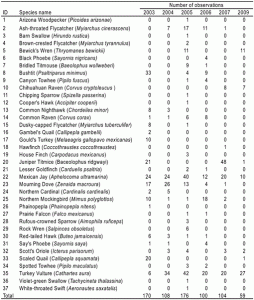Psaltriparus minimus
Bushtits are small gray birds with a pale brown cap, pale neck and upper breast, and white wing barring. Their overall body is gray variations with some southern populations having dark masks extending to the nape from the auriculars or supercilium (Raitt, R. (1967)). They have black legs and feet as well as a short black bill. Bushtits are sexually dimorphic (With the exception of eye color) With only a slight difference in weight between them, the average is 5.35 grams (Dunning 1933b). During their month of fledging the female bird’s Iris’ will begin to lighten in color, from a dark brown (belonging to juveniles of both sexes as well as males at any age) to a light colored yellow, white, to creamy color.
Order: Passeriformes
Family: Aegithalidae
Genus: Psaltriparus
Distribution

The bushtit is a year-round resident of the Western coast of the united states stretching from Canada down to Southern California and into Mexico and does not migrate, except for some southern populations where breeding has occurred at higher elevations in the foothills or higher.
In 2018 percentage of feeders visited in the Northwest dropped to 35.8% as opposed to their unusually high previous year at 37.8%, with an average of 11.2 individuals to a flock. The Southeast also had lower numbers in 2018 with 29.2% and a 6.9 average flock size. These numbers have fluctuated in the past years, but has been on a slow incline since the early 2000’s (2018. Project Feeder watch. Retrieved from https://feederwatch.org/wp-content/themes/feederwatch/downloads/TrendGraphPDFs/bushti.pdf).
Habitat
Various wooded habitats. They like to be in low, bushy thickets, specifically oak scrub and Pinion pines (Kaufman 2011)
Food Habits
Bushtits eat various insects including catarpillars, beetles, and ants, as well as some seeds and berries.
Sounds
Behavior
Very social, active, group-oriented passeriformes, usually foraging in flocks up to 40 if it is not nest-building.

Nesting
Nest building is completed by both birds creating a sturdy hanging pocket. Their nesting material includes plant and animal matter like feathers, twigs, and lichens!
Some reported in urban areas to have synthetic material like balloon ribbon and dental floss (Andrea Townsand, Christopher Barker, 2014)
Although they build nests they are also known for huddling in groups to stay warm on cold nights (Kaufman, 2011).


Population Trends and Conservation Issues
In a 2011 study the Bushtits proved to be resilient little birds in a study observing the effects of prescribed burns and wildfire on Oak Savannas of the Southwest. Bushtits were said to be observed in large numbers before and after burning events (Peter Ffolliott, Hui Chen, Gerald Gottfried, 2011).

Literature Cited
- Raitt, R. (1967). Relationships between Black-Eared and Plain-Eared Forms of Bushtits (Psaltriparus). The Auk, 84(4), 503-528. doi:10.2307/4083332
- Peter F. Ffolliott, Hui Chen, Gerald J. Gottfried. (2011).
“Bird Species and Numbers of Birds in Oak Savannas of the Southwestern Borderlands Region Including Effects of Burning,” 42(2)
Journal of the Arizona-Nevada Academy of Science
https://doi.org/10.2181/036.042.0203
- Hathcock, C. D., Mahowald, H. B., & Keller, D. C. (2013). Los Alamos National Laboratory Fall Avian Migration Monitoring Report 2010-12 (No. LA-UR-13-20413). Los Alamos National Lab.(LANL), Los Alamos, NM (United States).
- Dunning, J.B., Jr. (1993). CRC handbook of avian body masses. Boca Raton, FL: CRC Press
- Kaufman, K. (2001). Lives of north american birds. Boston: Houghton Mifflin.
- Project Feederwatch. (2018). Retrieved from file:///home/chronos/u-05359d6476d6201d5f45dada1a96a63b5085f728/Downloads/bushti.pdf
- Andrea K. Townsand, Christopher M. Barker. (2014). Plastic and the Nest Entanglement of Urban and Agricultural Crows. Retrieved from https://doi.org/10.1371/journal.pone.0088006
Media
- Distribution map-Sloane, S. A. (2001). Bushtit (Psaltriparus minimus), version 2.0. In The Birds of North America (A. F. Poole and F. B. Gill, Editors). Cornell Lab of Ornithology, Ithaca, NY, USA. https://doi-org.acces.bibl.ulaval.ca/10.2173/bna.598
- Peter F. Ffolliott, Hui Chen, Gerald J. Gottfried (2011)







Leave a Reply